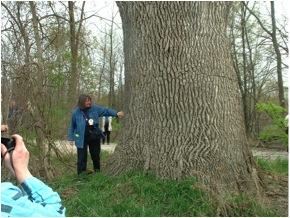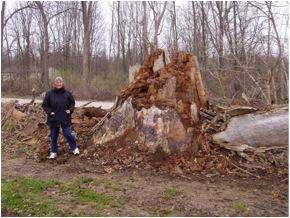The Nature Conservancy (TNC) has carried out telephone surveys of eligible voters to determine their attitudes about trees and forests and threats to them over 11 years – in 2005, 2007, 2008, 2010, and 2016. Leigh Greenwood will present these finding during a webinar on Friday 27 January. Go here to learn more and register for the webinar.
Michigan champion ash before & after being killed by emerald ash borer
While those surveyed consistently ranked economic concerns as more important than environmental ones, still they have been aware of threat from forest insects and diseases.
In 2016, 23% to 26% of respondents said that they considered diseases or insects that kill trees a “very serious” problem. Notably, these concerns were equal to those expressed about fires that destroy property and forests.
Gardening, hiking, and wildlife viewing are popular activities, engaged in by half or more of the respondents. Only 35% of respondents fish; only 15% hunt.
The sources of information on forest health issues that are most trusted by survey respondents have remained steady across regions and years:
- park “rangers” rank first, with 89% of respondents ranking them as “believable”;
- the state division of forestry ranks second, with 84% of respondents saying it is “believable”;
- the USDA Forest Service and scientists are tied for third, with 82% of respondents saying each is “believable”;
- also highly trusted (trusted by more than 70% of respondents) were the State Department of Agriculture, a local forester, and conservation organizations.
The public’s level of familiarity with the concept of forest pests nationwide has been between 53% and 59% of respondents since the Conservancy began polling in 2005. Levels of awareness were higher in 2010 than in either 2005 or 2016 –probably because of media attention to the emerald ash borer.
The specific pests asked about in the polls with the highest levels of awareness have remained Dutch elm disease and European gypsy moth – with somewhat over half the respondents saying they have heard of the problem. About a quarter of respondents have heard something about chestnut blight.
Levels of awareness have changed significantly over time for some regions and some pests.
In 2016, 50% of respondents in the “east north central” region HAVE NOT heard of the Asian longhorned beetle. This contrasts with 2010, when only 18% of respondents in the region said they had not heard about ALB. Perhaps this decline in awareness is because the outbreak in Clermont County Ohio is in a semirural area and does not get the media coverage that earlier outbreaks in cities did. Alternatively, because these polls are conducted in a population proportional sample, it may be that urban residents are not aware while rural residents (in the affected area) are indeed aware but are not captured in the sampling methodology.
Similarly, in 2016 more than a third of respondents in New England said they had not heard about the ALB; this lack of awareness is greater than the quarter who said they had not heard about the insect in 2010. Still, the number of people in the region who had “heard quite a bit about it” has held steady at one-third of respondents. In the Northeast more broadly, 48% in 2016 said they had not heard about ALB, compared to 42% in 2010.
Regarding the emerald ash borer, its spread has apparently led to greater awareness in the South. By 2016, 28% of respondents in the South have heard of it — compared to 18% in 2010. Awareness of EAB has remained steady in the East North Central region – at 76% of respondents. In 2005, when three of the five states in the region were polled, awareness was far lower – 57% said they had never heard of it.
Poll results showed that the proportion of respondents nation-wide who were “extremely or very concerned about non-native forest pests and diseases has declined from 54% in 2010 to 40% in 2016. While the poll does not inform us why this change has occurred, one probable explanation is that the emerald ash borer infestation is no longer front page news in most regions.
Levels of concern are highest in major cities and rural areas.
One of the purposes of the Conservancy’s polling is to measure the effectiveness of the organization’s efforts to educate campers and others about the pest risk associated with firewood. (Visit www.dontmovefirewood.org to see the extensive outreach program and how you can become involved.) Consequently, pollsters paid considerable attention to attitudes about using and moving firewood. In 2016, 47% of respondents say they never burn firewood at home; a different 51% say they never burn firewood when travelling away from home.
Of those who burn firewood at home or outdoors, few now admit to moving firewood – especially in the Northeast and Midwest. In those two regions, 70% plus say they never move it. Those who do move firewood say they move it shorter distances (mostly less than 50 miles).
The polls show the impact of outreach efforts nationwide. In the Northeast and Midwest, those who admit to moving firewood several times have dropped by about half. Indeed, the nation-wide proportion of respondents who admit to moving firewood in 2016 is below the proportion in the most affected region in 2007.
Across the country, 37% have heard that they should not move firewood – slightly above the 34% in 2010. Respondents who have heard the firewood message say this information has made them much less likely to move firewood.
However, there are huge regional differences. In the Midwest (reported as two subregions), between 56% and 70% have heard the firewood message. In New England, 49% of respondents have heard the message. In the Mid-Atlantic region, 40% remember having heard a message about not moving firewood. However, in the South and in the Pacific states, only 30% or fewer of respondents remember having seen or heard a message about firewood. In Rocky Mountain states, the proportion falls to 11%!!!. [ insert the graph? Would it be readable?]
The overwhelming majority of respondents say they are willing to buy firewood where they will burn it after hearing information about pest threat. This proportion was 84% in 2016 – although this is below the 90% who responded positively in 2005.
Types of information that respondents say they are most likely to pay attention to:
- Brochure at a park 90% say would pay attention
- Information from friend or neighbor 88%
- Billboard on highway 84%
- Radio ad 78%
- Email at time of reserving campground 77% (major program effort)
- Label on firewood package 77% (but is this information seen too late – e.g., after people have already arrived with wood in tow?)
- Ad on TV 75%
- Booth at special event or farmers’ market 75% (DMF has had such booths for years)
Lower proportions said they would pay attention to such other outreach methods as an article in a local newspaper, article in utility bill mailing or e-newsletter, advertisement in outdoor outfitter catalog or newspaper … or even website focused on firewood consumers. Responses vary by age groups. Predictably, digital media categories perform more persuasively in the younger demographics.
The preferred message is “buy it where you burn it.” The very similar “buy local, burn local” is also well accepted by the public according to the polling results, but due to its more limited use area (mostly Vermont and Canada at this time) the campaign recommends using Buy It Where You Burn It to be consistent.
CONCLUSIONS:
- Use the slogan that the public prefers – when practical; the “local” message might not fit if the state’s or agency’s program requires that the wood be treat or either allows or encourages gathering of downed wood for the fire.
- Outreach is working – the public is changing its behavior to move firewood less frequently and for shorter distances.
- Use trusted messengers and outlets/places where people are receptive.
- Awareness is temporary; it fades over time — so don’t stop putting the message out!!!!
We welcome comments that supplement or correct factual information, suggest new approaches, or promote thoughtful consideration. We post comments that disagree with us — but not those we judge to be not civil or inflammatory.
Posted by Faith Campbell

